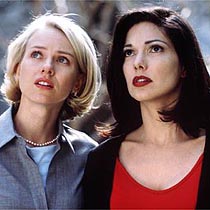| |
| |
|
|
|
|
"Mulholland
Drive"
(David Lynch, director)
Review by Radmila Djurica |
|
David
Lynch, the creator of the cult serial “Twin Peaks,” is known
for tracing the psychology of his characters to the hidden
crime of the melancholy American middle class, all against
idyllic backgrounds. Ever since Laura Palmer [Twin Peaks],
Lynch has focused on the characteristics of one kind of woman
in his films. He is like a modern Hitchcock, returning to
a similar female character, just as Hitchcock did. Lynch’s
women always have a mysterious and dark secret, underscored
by the sadness created by the wide-open scenography of wide
landscapes. In Mulholland Drive, as in Twin Peaks, Wild at
Heart, Blue Velvet and Lost Highway, women are hallucinating,
sad and bizarre.
|
|
Mulholland
Drive follows strange characters, with disappearing elements,
as in other Lynch films. Slow motion gives the film an accent
so typical for Lynch. Typical and effective, but also predictible.
Mulholland Drive lasts too long. The border between nightmares,
dreams and reality is shifted any which way, and it's hard
to keep track.
|
 |
|
Rita
is the femme fatale, a woman who has survived a car accident,
losing her memory, a story that has been used before. She
runs into a young, naive actress who offers to help her find
out about herself. These two completely different women are
attracted to each other, signifying the attraction of light
and darkness. A young blonde actress symbolizes light and
innocence, and the dark mysterious femme fatale Rita, a brunette,
symbolizes confused, dark sexuality that turns out to be bisexuality.
The two women become lovers, and even after they become lovers,
the mystery remains unsolved, blurry to the very end. It is
too predictable for Lynch to use an object not related to
the story, a strange-looking box with the key, as a fetish
to represent evil.
|
|
|
